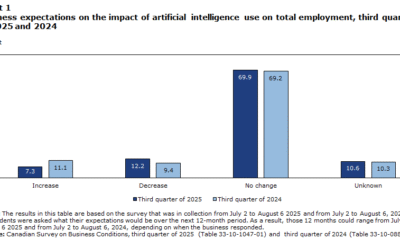AI Insights
Film Schools Are Embracing AI. Should They?

Jake Panek, a 20-year-old film major, says he’s had a great time at DePaul University in Chicago, and a very positive experience with the school’s cinema program. However, a recent email alerting students to a new course in “AI screenwriting” triggered a wellspring of untapped rage in him.
The email, which was circulated last week, offered undergrads the opportunity to examine “the rapidly evolving role of artificial intelligence in the screenwriting process” and to help students “explore how AI can support and enhance creativity in writing for film and television.” Panek wasn’t having it.
Not long after he received the email, the young filmmaker was so angry that he took to Instagram to express his thoughts: “seeing this email made me embarrassed to be a depaul film student,” he wrote, tagging the school and its film program. “I think the professor that’ll be ‘teaching’ this course, every student who enrolls in this course, and everyone who is allowing this course to happen should seriously reconsider it—THIS COURSE SHOULD NOT BE A THING.”
When Panek talked to me about the program, his disdain for the class didn’t seem to have waned much. “I think it’s bullshit,” he told me. “I’m just so angry at the very existence of it.”
DePaul’s School of Cinematic Arts is considered one of the top film programs in the country, and it has often distinguished itself by allowing the student body to access cutting-edge equipment and software. Recently, however, officials at the school have become interested in AI. In May, the film program held an “AI in the Arts” symposium, designed to explore “the transformative role of Artificial Intelligence in the arts.” Even before this event, certain people within the administration have been pushing the film program to further explore integration of AI into its curriculum, said Matthew Quinn, the DePaul professor who has been tasked with teaching the new screenwriting course.
“Our school, the School of Cinematic Arts, is in the College of Computing and Digital Media,” said Quinn. “Our dean is from the School of Computing, so they’re of course very invested in AI.” DePaul also has an AI task force, he added, noting that there was a university-wide effort to study and integrate AI into the curriculum.
What does an “AI screenwriting” course entail? Quinn said that the course was very similar to other screenwriting courses that he’d taught, with the key difference being that generative AI was used to help create and shape the material. “So, like when it comes to generating log lines and then working on character bios and character development, and then ultimately culminating with a step outline [a step outline is a summary of a script’s scenes],” Quinn said that students in the class would “collaborate” with ChatGPT. Later, students would participate in a workshop where their assignments were discussed, Quinn said. Students would talk about their creative process, discuss their collaborations with the chatbots, and explain what was “helpful” and what wasn’t. The class was designed to replicate “the process of developing a script,” he said.
Quinn also noted that, currently, DePaul’s film program has a policy that requires students to acknowledge the use of AI in screenwriting. If students use it, they have to explain why and how, he said. It’s currently at the faculty’s discretion to determine whether students can use AI in that way or not, he added.
DePaul isn’t the only film school that has begun to offer AI-related courses. The University of Southern California recently launched an AI for Media and Storytelling studio, which is designed to explore how the tech can be integrated into the film, media, and journalism industries. UCLA Extension recently launched a new course called “Creative Process in the Age of AI,” and even the American Film Institute has dipped its toes into the space, having debuted a three-day seminar series on “Storytelling and AI” earlier this year.
Holly Willis, the co-director of USC’s AI studio, said the school got interested in developing a new AI program in 2023, not long after the release of ChatGPT and the groundswell of cultural interest in generative AI. “It was kind of around that same time,” Willis said. “I think at that moment, it was such a huge thing, we realized ‘Oh, this is a really important shift’,” she said.
Willis, who has now taught multiple courses examining potential creative applications of AI, describes herself as “deeply critical” of the technology but also said that she was “very excited about [the] new forms of storytelling” that the tech could provide. “I think there are definite problems with generative AI and how it’s been introduced to filmmakers and artists, and how, right now, much of the ownership of the tools is within a corporate context,” she said. “But at the same time, the work that I’m seeing artists do is really exciting.”
In an article about AI’s use in the arts, Willis highlights the work of Souki Mansoor, a former documentarian who “stumbled into the AI filmmaking rabbit hole” and now works in the tech industry. Mansoor, who served as a guest speaker in one of Willis’ AI-themed classes, currently works for OpenAI as “Sora Artist Program Lead,” according to her LinkedIn profile. It’s unclear what that really means, but Mansoor, who describes herself as a “recovering filmmaker,” has produced some visual pieces using platforms like the ones OpenAI is currently marketing. Indeed, in 2023, she “generated” a short film dubbed An AI Dreams of Dogfish, using prompts entered into RunwayML’s Gen2.
While Willis expresses excitement for works of the sort that Mansoor has produced, she notes that some of her students seem a little concerned about the infusion of AI into the arts. “I would say that students are very nervous,” she said. “The first class I taught when we started this initiative, students were very wary…like, ‘Why are we paying for this education when anyone can now create these images so easily?’” They didn’t realize that you still needed “skills and storytelling,” she said.
As for DePaul’s AI screenwriting course, Quinn said he hasn’t seen a ton of pushback from students, but there doesn’t appear to be a whole lot of interest either. “Right now, there’s not even that many students enrolled in it,” Quinn told me. “It might not even run.” He further clarified that the course wasn’t about mindlessly embracing AI. Instead, he described it as a workshop designed to expose students to different perspectives on the “current state-of-play” of the technology and what it could potentially offer creatives. Quinn admitted that he, himself, was “conflicted” about AI’s use in the creative arts. “It’s not like I’m a huge proponent of AI and love AI,” he said. “It’s more like, as an educator, I feel like I’m doing a disservice to students if I’m not exposing them to this or pretending like it’s not happening.” Quinn wants students to make an informed decision on whether they want to engage with AI or not, and to do that, they need to understand it.
For students like Panek, however, the whole thing seems like a huge betrayal of the fundamentals of the creative process. “I understand the desire, as an artist, to take a shortcut,” Panek offered. After all, making movies is really difficult, and it can often feel like the world is against you. But Panek said that he and his fellow students find their own ways to solve problems—that’s part of making movies. “Taking the shortcut of generative AI” ultimately “doesn’t do anything for anyone,” he said. “You’re not gaining anything by typing something into a computer and having it spit something back at you,” he added.
“Filmmaking is hard,” Panek said, while noting that if “you’re not willing to…find your own solutions to things, and your first thought is just, ‘Oh, well generative AI exists, let’s just use that’” it’s hard to really call yourself an artist.
AI Insights
Pittsburgh’s AI summit: five key takeaways

The push for artificial intelligence-related investments in Western Pennsylvania continued Thursday with a second conference that brought together business leaders and elected officials.
Not in attendance this time was President Donald Trump, who headlined a July 15 celebration of AI opportunity at Carnegie Mellon University.
This time Gov. Josh Shapiro, U.S. Sen. David McCormick and others converged in Bakery Square in Larimer to emphasize emerging public-private initiatives in anticipation of growing data center development and other artificial intelligence-related infrastructure including power plants.
Here’s what speakers and attendees at the summit were saying.
AI is not a fad
As regional leaders and business investors consider their options, BNY Mellon’s CEO Robin Vince cautioned against not taking AI seriously.
“The way to get left behind in the next 10 years is to not care about AI,” Vince said
“AI is transforming everything,” said Selin Song during Thursday’s event. As president of Google Customer Solutions, Song said that the company’s recent investment of $25 million across the Pennsylvania-Jersey-Maryland grid will help give AI training access to the more than 1 million small businesses in the state.
Google isn’t the only game in town
Shapiro noted that Amazon recently announced plans to spend at least $20 billion to establish multiple high-tech cloud computing and AI innovation campuses across the state.
“This is a generational change,” Shapiro said, calling it the largest private sector investment in Pennsylvania’s history. “This is our next chapter in innovative growth. It all fits together. This new investment is beyond data center 1.0 that we saw in Virginia.”
Fracking concerns elevated
With all of the plans for new power-hungry data centers, some are concerned that the AI push will create more environmental destruction. Outside the summit, Food & Water Watch Pennsylvania cautioned that the interest in AI development is a “Trojan horse” for more natural gas fracking. Amid President Donald Trump’s attempts to dismantle wind and solar power, alternatives to natural gas appear limited.
Nuclear ready for its moment
But one possible alternative was raised at the AI conference by Westinghouse Electric Company’s interim CEO Dan Summer.
The Pittsburgh-headquartered organization is leading a renewed interest in nuclear energy with plans to build a number of its AP 1000 reactors to help match energy needs and capabilities.
Summer said that the company is partnering with Google, allowing them to leverage Google’s AI capabilities “with our nuclear operations to construct new nuclear here.”
China vs. ‘heroes’
Underlying much of the AI activity: concerns with China’s work in this field
“With its vast resources, enormous capital, energy, workforce, the Chinese government is leveraging its resources to beat the United States in AI development,” said Nazak Nikakhtar, a national security and international trade attorney who chaired one of the panels Thursday.

Speaking to EQT’s CEO Toby Rice and Groq executive Ian Andrews, Nikakhtar outlined some of the challenges she saw in U.S. development of AI technology compared to China.
“We are attempting to leverage, now, our own resources, albeit in some respects much more limited vis-a-vis what China has, to accelerate AI leadership here in the United States and beat China,” she said. “But we’re somewhat constrained by the resources we have, by our population, by workforce, capital.”
Rice said in response that the natural resources his company is extracting will help power the country’s ability to compete with China.
Rice drew a link between the 9/11 terror attacks 24 years earlier and the “urgency” of competing with China in AI.
“People are looking to take down American economies,” Rice said. “And we have heroes. Never forget. And I do believe that us winning this race against China in AI is going to be one of the most heroic things we’re going to do.”
Eric Jankiewicz is PublicSource’s economic development reporter and can be reached at ericj@publicsource.org or on Twitter @ericjankiewicz.
AI Insights
Commanders vs. Packers props, SportsLine Machine Learning Model AI picks, bets: Jordan Love Over 223.5 yards

The NFL Week 2 schedule gets underway with a Thursday Night Football matchup between NFC playoff teams from a year ago. The Washington Commanders battle the Green Bay Packers beginning at 8:15 p.m. ET from Lambeau Field. Second-year quarterback Jayden Daniels led the Commanders to a 21-6 opening-day win over the New York Giants, completing 19 of 30 passes for 233 yards and one touchdown. Jordan Love, meanwhile, helped propel the Packers to a dominating 27-13 win over the Detroit Lions in Week 1. He completed 16 of 22 passes for 188 yards and two touchdowns.
NFL prop bettors will likely target the two young quarterbacks with NFL prop picks, in addition to proven playmakers like Deebo Samuel, Romeo Doubs and Zach Ertz. Green Bay’s Jayden Reed has been dealing with a foot injury, but still managed to haul in a touchdown pass in the opener, while Austin Ekeler (shoulder) does not carry an injury designation for TNF. The Packers enter as a 3-point favorite with Green Bay at -172 on the money line, while the over/under is 49 points. Before betting any Commanders vs. Packers props for Thursday Night Football, you need to see the Commanders vs. Packers prop predictions powered by SportsLine’s Machine Learning Model AI.
Built using cutting-edge artificial intelligence and machine learning techniques by SportsLine’s Data Science team, AI Predictions and AI Ratings are generated for each player prop.
For Packers vs. Commanders NFL betting on Monday Night Football, the Machine Learning Model has evaluated the NFL player prop odds and provided Commanders vs. Packers prop picks. You can only see the Machine Learning Model player prop predictions for Washington vs. Green Bay here.
Top NFL player prop bets for Commanders vs. Packers
After analyzing the Commanders vs. Packers props and examining the dozens of NFL player prop markets, the SportsLine’s Machine Learning Model says Packers quarterback Love goes Over 223.5 passing yards (-112 at FanDuel). Love passed for 224 or more yards in eight games a year ago, despite an injury-filled season. In 15 regular-season games in 2024, he completed 63.1% of his passes for 3,389 yards and 25 touchdowns with 11 interceptions. Additionally, Washington allowed an average of 240.3 passing yards per game on the road last season.
In a 30-13 win over the Seattle Seahawks on Dec. 15, he completed 20 of 27 passes for 229 yards and two touchdowns. Love completed 21 of 28 passes for 274 yards and two scores in a 30-17 victory over the Miami Dolphins on Nov. 28. The model projects Love to pass for 259.5 yards, giving this prop bet a 4.5 rating out of 5. See more NFL props here, and new users can also target the FanDuel promo code, which offers new users $300 in bonus bets if their first $5 bet wins:
How to make NFL player prop bets for Washington vs. Green Bay
In addition, the SportsLine Machine Learning Model says another star sails past his total and has nine additional NFL props that are rated four stars or better. You need to see the Machine Learning Model analysis before making any Commanders vs. Packers prop bets for Thursday Night Football.
Which Commanders vs. Packers prop bets should you target for Thursday Night Football? Visit SportsLine now to see the top Commanders vs. Packers props, all from the SportsLine Machine Learning Model.
AI Insights
Adobe Says Its AI Sales Are Coming in Strong. But Will It Lift the Stock?

Adobe (ADBE) just reported record quarterly revenue driven by artificial intelligence gains. Will it revive confidence in the stock?
The creative software giant late Thursday posted adjusted earnings per share of $5.31 on revenue that jumped 11% year-over-year to a record $5.99 billion in the fiscal third quarter, above analysts’ estimates compiled by Visible Alpha, as AI revenues topped company targets.
CEO Shantanu Narayen said that with the third-quarter’s revenue driven by AI, Adobe has already surpassed its “AI-first” revenue goals for the year, leading the company to boost its outlook. The company said it now anticipates full-year adjusted earnings of $20.80 to $20.85 per share and revenue of $23.65 billion to $23.7 billion, up from adjusted earnings of $20.50 to $20.70 on revenue of $23.50 billion to $23.6 billion previously.
Shares of Adobe were recently rising in late trading. But they’ve had a tough year so far, with the stock down more than 20% for 2025 through Thursday’s close amid worries about the company’s AI progress and growing competition.
Wall Street is optimistic. The shares finished Thursday a bit below $351, and the mean price target as tracked by Visible Alpha, above $461, represents a more than 30% premium. Most of the analysts tracking the stock have “buy” ratings.
But even that target represents a degree of caution in the context of recent highs. The shares were above $600 in February 2024.
-

 Business2 weeks ago
Business2 weeks agoThe Guardian view on Trump and the Fed: independence is no substitute for accountability | Editorial
-
Tools & Platforms1 month ago
Building Trust in Military AI Starts with Opening the Black Box – War on the Rocks
-

 Ethics & Policy2 months ago
Ethics & Policy2 months agoSDAIA Supports Saudi Arabia’s Leadership in Shaping Global AI Ethics, Policy, and Research – وكالة الأنباء السعودية
-

 Events & Conferences4 months ago
Events & Conferences4 months agoJourney to 1000 models: Scaling Instagram’s recommendation system
-

 Jobs & Careers2 months ago
Jobs & Careers2 months agoMumbai-based Perplexity Alternative Has 60k+ Users Without Funding
-

 Podcasts & Talks2 months ago
Podcasts & Talks2 months agoHappy 4th of July! 🎆 Made with Veo 3 in Gemini
-

 Education2 months ago
Education2 months agoVEX Robotics launches AI-powered classroom robotics system
-

 Education2 months ago
Education2 months agoMacron says UK and France have duty to tackle illegal migration ‘with humanity, solidarity and firmness’ – UK politics live | Politics
-

 Funding & Business2 months ago
Funding & Business2 months agoKayak and Expedia race to build AI travel agents that turn social posts into itineraries
-

 Podcasts & Talks2 months ago
Podcasts & Talks2 months agoOpenAI 🤝 @teamganassi



















